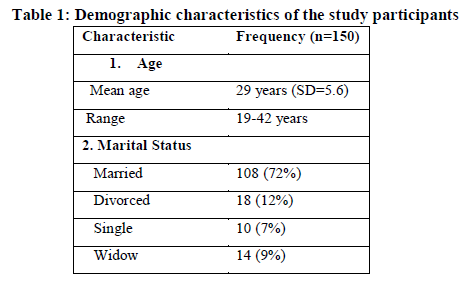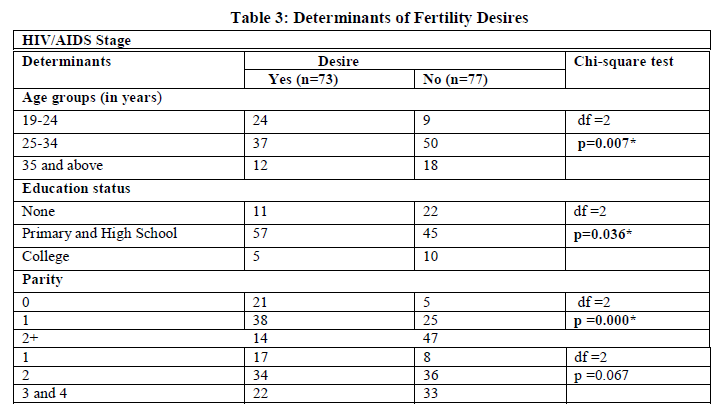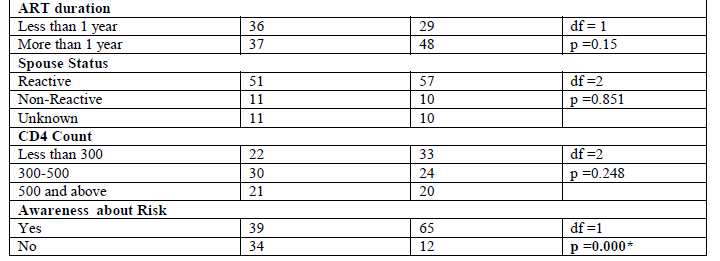IJCRR - 5(19), October, 2013
Pages: 91-96
Date of Publication: 19-Oct-2013
Print Article
Download XML Download PDF
FERTILITY DESIRES AND CONTRACEPTION PRACTICES AMONG HIV POSITIVE WOMEN ATTENDING ANTIRETROVIRAL THERAPY CENTRE(A.R.T) OF A TERTIARY CARE HOSPITAL IN DAVANGERE
Author: Sarvamangala K., Arshiya
Category: Healthcare
Abstract:Background: Pregnancy among HIV positive women is an issue of public health importance because of poor maternal outcomes and paediatric HIV infections. The recent advances in Anti-Retroviral therapy and the focus on Prevention of Parent to Child Transmission (PPTCT) have radically changed HIV Positive Women's Fertility options. People with HIV infection may wish to plan pregnancy, limit their family, or avoid pregnancy. They may have a different outlook on future family planning but however, there is limited understanding of their reproductive needs. Objectives: 1. To determine the proportion of HIV positive women on ART using modern methods of contraception. 2. To assess the fertility desires and contraceptive choices and factors influencing these choices. Methods : ? Study Design: Cross-Sectional, descriptive study. ? Study Population: HIV positive women on antiretroviral therapy. ? Study Area: ART centre at CG Hospital Davangere. ? Study Period: 2 months (October 1st to 30th November 2012 ) ? Sample size: 150 HIV positive women. Statistical analysis: Percentage and chi-square Results: Use of any modern method of contraception was 52%. 48% of HIV positive women expressed a desire for a child in the future. Age, education status, parity and awareness about risk of transmission to baby had significant association with fertility desire (p< 0.05). Women in stage 1 or 2 and higher CD4 count had desire for children as they were medically better than those in stage 3 or 4 , lower CD4 count and on long ART duration who were generally ill. Conclusion : Health professionals should encourage HIV positive women's reproductive choices by increasing counselling by considering the factors influencing her desires This has to be followed by appropriate contraception provision at the time of HIV diagnosis and during follow up
Keywords: fertility, contraception, HIV positive women.
Full Text:
INTRODUCTION
The recent advances in Anti-Retroviral therapy and the focus on Prevention of Parent to Child Transmission (PPTCT) have radically changed HIV Positive Women's Fertility options1. HIV/AIDS may have either impact on their fertility desires as the fear of ill health may make them to consider stopping child bearing while family or community obligations make them to have desire for bear children. Hence fertility issues for them are becoming increasingly important. People with HIV infection may wish to plan pregnancy, limit their family, or avoid pregnancy2.
The desire of HIV-infected persons to have children in the future has significant implications for the transmission of HIV to sexual partners and newborns3. The risk of HIV transmission among individual couples is likely to increase as more infected individuals choose to have children with their HIV-negative partners. Despite the growing importance of fertility issues for HIV-infected men and women, little is known about their actual fertility desires and intentions.
They may have a different outlook on future family planning but however, there is limited understanding of their reproductive needs4.Therefore, the present paper tries to reflect the effect of HIV on fertility desire for children. Further, an attempt has also been made to give empirical evidences of desire for children and contraceptive use among HIV positive women.
Objectives:
1. To determine the proportion of HIV positive women on ART using modern methods of contraception.
2. To assess the fertility desires and contraceptive choices and factors influencing these choices.
METHODOLOGY
This is a facility based Cross-Sectional, descriptive study. The study population comprised HIV positive women on antiretroviral therapy who attended ART centre at Chigateri General Hospital, Davangere. The study was carried for over 6 months from June 1st to 30th November 2012.Sample size comprised 150 HIV positive women.
Data Collection:
Respondents were interviewed using pre-tested, semi-structured questionnaire about their fertility desires and contraception use while information about HIV/AIDS diagnosis, Anti-Retroviral therapy, CD4 counts and other details were collected from their records.
Statistical analysis was done using Proportions, Chi square test. HIV positive women aged between 15-45 years, sexually active, Non Pregnant and registered on ART at time of data collection and those consenting to participate in the study were included.
RESULTS


The mean age of study participants was 29 years with a standard deviation of 5.6 years. The highest and lowest ages were 42 and 19 years respectively (age range is 19-42 years). Majority (72%) were married followed by 12% who were divorced. About 9% were widow and 7% were single (not ever married but having or staying with a partner). Majority (60%) had no education or primary education while 30% had secondary education and only 10% had tertiary education (college or graduation). 60% were working while 40% were not working due to ill health.

Out of 150 study participants, 83% (n=124) have ever borne children. 53% (n= 79) had given birth before diagnosis of HIV while 30% (n= 45) had given birth after diagnosis of HIV. About 14 % (n=21) reported of having either spontaneous or induced abortions after diagnosis of HIV. 72% (n=142) of these women had either spouse or partner also HIV positive. Overall 48% (n=73) desired for more children while 52% (n=77) had no desire.
The current contraception use of all modern methods was around 52% (n=78).Relative’s pressure 17% to have a complete family was the most common reason given by most women who desired more children. 10 % reported they have single child so wanted to have at least one more child. About 9% had only daughter(s) so they want to have a son while 5% did not have any issues so they desired to have at least one child. Risk of transmitting HIV to the baby 32% emerged as the most common reason for not desiring to have more children.10% did not desire because of health concerns like already ill and won’t be able to take care of children. Another concern was baby born will also be not healthy so it will be extra burden on them. 8% were single parent while 2% reported financial constraints for not desiring more children.28% reported fear of side effect for not using contraceptives while 12% did not wanted to take too many drugs.6% reported that spouse were not willing/ allowing them to use. 2% reported they were ill or abstaining.


Table 3, shows that age, education status, parity and awareness about risk of transmission to baby had significant association with fertility desire (p< 0.05).While a positive trend was observed between HIV/AIDS stage, duration of ART, CD4 counts and Spouse status. DISCUSSION
In this study it was found that 48% of HIV positive women expressed a desire for a child in the future. Women, who desired a child were younger, married, in a sexually active relationship with no children, and had partners who desired a child. These proportions are similar to those found in others studies (Panozzo et al5., 2003, Loutfy et al6., 2009, Cooper et al7., 2009). Age is also a predictor for fertility desires. As the HIV epidemic has spread in developing countries, the highest rate of infection has occurred in women aged 15 to 29 [8,9] and coincides with the beginning and peak of their reproductive lives
This study showed that the number of children is associated with the desire for a child. Similar findings were found in many studies.10,11,12 Although there was a strong but not significant association in this study, preference for a male child was a common reason for wanting a child similar to studies in Asia regions.13,14
Higher education status of the couple and especially HIV positive women and awareness of the risk of transmission was very strongly associated with negative fertility desire. Our findings confirm those of other individual level studies: that awareness of HIV positive status leads desire to stop child bearing among married men and women (Nduna and Farlane15, Nattabi et. al.16)
There was no significant association between medical factors and fertility desires, except for use of contraception. Respondents who used contraception tended to be more likely to desire a child, although a similar study by Loutfy et al6 found no such association. In the present study, women who used contraception were more likely to desire a child than those who did not. The use of contraception did not necessarily indicate a desire not to have a child. Rather, the use of contraception was intended to control the timing of conception and birth. A partner’s/ spouses’ nonreactive state was found to be positively associated with desire for a child though it was not found to be significant. This is consistent with studies from Northeast Brazil.10,17
Women in stage 1 or 2 and higher CD4 count had desire for children as they were medically better while in stage 3 or 4 and lower CD4 count did not desire as they were generally ill. Women soon after initiation of ART were apprehensive about child bearing while after a year had positive desire as they may adjusted to the therapy. Women on longer duration of ART wanted to stop child bearing because of adverse effects of ART. Similar study conducted in the United States concluded that overall, 28-29 percent of HIV-infected men and women receiving medical care desire children in the future. These expressed differences in fertility desires could assist reproductive health services planners in designing programmes that address couples’ aspirations and needs.
Use of any modern method of contraception was 52% which was similar to the study in Malawi18. Condom use, especially among HIV positive couples, was lower than that reported in other studies (Panozzo et al5). However, more than one fifth of sexually active HIV infected couples were still not using any contraceptive method at the time of interview despite counselling. This finding is similar to the study conducted by Vimercati (1999).
CONCLUSION
The relationship between HIV and fertility desires is very complex and still it is not well understood. As far as desire for children is concerned, most of the study population wanted to have children but their HIV status limit them from resuming parenthood. Despite knowing their status a considerable proportion desired to have at least one child in future.
The fact that many HIV infected adults desire and aspirations to have children has waved way for interventions to prevent vertical and heterosexual transmission of HIV. Peer counselors, health care workers play a crucial role in decision-making about child bearing and childrearing by counseling on safe sex practices, use of contraception and the desire for child needs to be addressed timely and appropriately to the HIV infected clients. integration of reproductive health and family planning services into the programs should be made mandatory. Behavioral change researches regarding sexual behavior and contraceptive use involving HIV positive women and their spouses also need to be conducted.
References:
- Kalyanwala S, S Iyenger and S Janardhan. Factors influencing the fertility intentions of people living with HIV/AIDS in Karnataka. New Delhi: Population Council
- Elizabeth K. Harrington, Sara J. Newmann, Maricianah Onono,Katie D. Schwartz et al. Fertility Intentions and Interest in Integrated Family Planning Services among Women Living with HIV in Nyanza Province, Kenya: A Qualitative Study.Infectious Diseases in Obstetrics and Gynecology.2012,22;8
- Factors Influencing Reproductive Choices of HIV Infected Women in India
- UNAIDS. Report on Global AIDS Epidemic. Geneva: UNAIDS; 2008
- Panozzo L, Battegay M, Friedl A and Vernazza P. L. 2003. High risk behaviour and fertility desires among heterosexual HIV-positive patients with a serodiscordant partner--two challenging issues. Swiss Med Wkly, 2003, 133; 124-7.
- M. R. Loutfy, T. A. Hart, S. S. Mohammed, et al., “Fer-tility Desires and Intentions of HIV Positive Women of Reproductive Age in Ontarrio, Canada: A Cross-Sectional Study,” PLos One, Vol. 4, No. 12, 2009, pp. 1-10. doi:10.1371/journal.pone.0007925
- Cooper D, Moodley J, Zweigenthal V, Bekker L, Shah I and Myer L. 2009. Fertility intentions and reproductive health care needs of people living with HIV in Cape Town, South Africa: implications for integrating reproductive health and HIV care services. AIDS Behav.2009, 13 (1); 38-46.
- UNAIDS, “PNG UNGASS Country Report,” 2010.http://data.unaids.org/pub/Report/2008/papua_new_guinea_2008_country_progress _report_en.pdf
- National AIDS Council Secretariat and National Depart-ment of Health (NACS and NDOH), “The 2007 Estima-tion Report on the HIV Epidemic in Papua New Guinea,” Port Moresby, 2007.
- A. Nobrega, A. F. Oliveira, T. M. Galvoa, et al., “De-sire for a Child among Women Living with HIV/AIDS in Northeast Brazil,” AIDS Patient Care and STDs, Vol. 21, No. 4, 2007, pp. 261-267. doi:10.1089/apc.2006.0116
- L. Myer, C. Morroni and K. Rebe, “Prevalence and De-terminants of Fertility Intentions of HIV-Infected Women and Men Receiving Antiretroviral Therapy in South Af-rica,” AIDS Patient Care and STDs, Vol. 21, No. 4, 2007, pp. 278-285. doi:10.1089/apc.2006.0108
- L. J. Chen, K. A. Phillips, D. E. Kanouse, et al., “Fertility and Intentions of HIV-Positive Men and Women,” Fam-ily Planning Perspectives, Vol. 33, No. 4, 2001, pp. 144- 152.
- N. Ko and M. Muecke, “Reproductive Decision-Making Among HIV Positive Couples in Taiwan,” Journal of Nursing Scholarship, Vol. 37, No. 1, 2005, pp. 41-47. doi:10.1111/j.1547-5069.2005.00008.x
- P. Oosterhoff, N. Anh Thu, N. Hnah Thuy, et al., “Hold-ing the Line: Family Responses to Pregnancy and the De-sire for a Child in the Context of HIV in Vietnam,” Cul-ture, Health and Sexuality, Vol. 10, No. 4, 2008, pp. 403-416. doi:10.1080/13691050801915192
- NDUNA, M. and FARLANE, L. 2009. Women living with HIV in South Africa and their concerns about fertility. AIDS Behav, 13 Suppl 1, 62-5.
- Nattabi, B., Li, J., Thompson, S. C., Orach, C. G. and Earnest, J. 2009. A systematic review of factors influencing fertility desires and intentions among people living with HIV/AIDS: implications for policy and service delivery. AIDS Behav, 13, 949-68.
- R. A. da Silverira, G. A. Fonsechi-Carvasan, M. Y. Ma-kuch, et al., “Factors Associated with Reproductive Op-tions in HIV-Infected Women,” Contraception, Vol. 71, No. 1, 2004, pp. 45-50.
- National Statistical Office (NSO)[MALAWI], A. O. M. 2010. Malawi Demographic and Health Survey 2010. Calverton, Maryland: NSO and ORC Macro.
|






 This work is licensed under a Creative Commons Attribution-NonCommercial 4.0 International License
This work is licensed under a Creative Commons Attribution-NonCommercial 4.0 International License